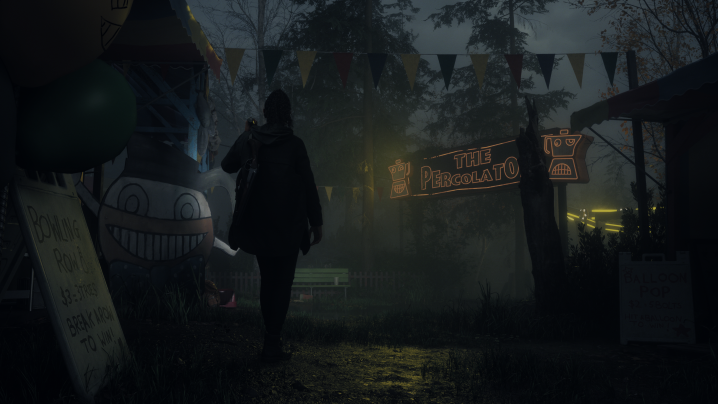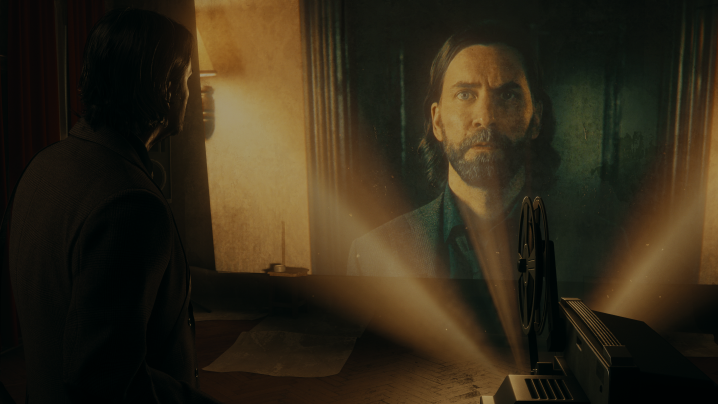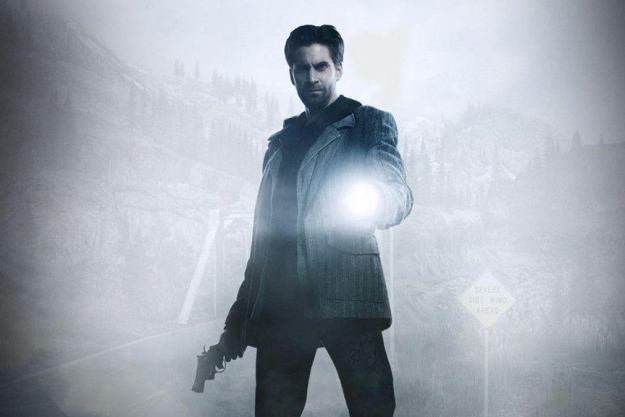Like Twin Peaks’ Dale Cooper trapped in the Black Lodge, Alan Wake has been in purgatory for a very long time.
Wake found himself stuck in the mysterious Dark Place at the end of his first game, and that would become a poetic tragedy. Funding troubles paired with a Microsoft partnership that would complicate the series’ publishing rights would force developer Remedy to move on to new titles like 2019’s Control. Still, writer Sam Lake would sit on an idea for a sequel for over a decade, just waiting for the moment when it could be freed from its own Dark Place.
That moment is almost here, as Alan Wake 2 is set to launch on October 27 with Epic Games’ assistance. With 13 years between games, Remedy has had a lot of time to dream up a more ambitious — and much stranger — survival horror sequel that could pay off the original game’s cliffhanger ending while totally subverting fans’ expectations.
After playing a lengthy demo of Alan Wake 2 earlier this month, it was immediately clear to me that Lake and Remedy had a lot of pent-up creative energy they were dying to unload. The two chapters I played weren’t just a total reinvention of the first game’s formula, but an avant-garde horror experience that wears its David Lynch influence on its sleeve. If the first game was Twin Peaks, Alan Wake 2 is very much Twin Peaks: The Return.
Puzzle pieces
The first half of my demo would throw me into familiar and unfamiliar territory in the same breath. Rather than controlling Alan Wake, I’m following FBI agent Saga Anderson as she investigates a small town. While the character is totally new to me, there’s a familiarity to the gameplay. Like a recent Resident Evil game, I explore every nook and cranny of a richly detailed world grabbing items, solving the occasional puzzle, and engaging in third-person shootouts with monsters that aren’t unlike Resident Evil 4’s villagers.
It’s certainly a pivot from the first game, leaning more into traditional survival horror design, but it wasn’t a surprise for Remedy itself. Speaking with Lake during the preview event, the creative director explained that the sequel went through several iterations over the past decade. The final version that we’re getting in October is actually closer to what the series almost was originally.
“Alan Wake had a very convoluted path of finding its identity,” Lake tells Digital Trends. “We were exploring very different IP ideas before we landed on it. And then it was supposed to be a free-roaming open-world game, and we were struggling with that a lot. The world was still built for an open world, so you get that illusion. What’s interesting to me is that Alan Wake 2, from its early concept document to what the game actually is, is much closer to that original structure than any other Remedy game has been.”

While the structure is familiar, the Saga chapter I played is teeming with creative energy. My adventure would take me to a meticulously detailed theme park called Coffee World, where I’d fight off some Taken baddies while navigating around caffeinated attractions like The Percolator. It’s an absurd set piece that feels totally consistent with the oddball nature of the world around me.
I’d also get to spend a lot of time inside Saga’s Mind Palace. Here, I’m able to take any clues I’ve collected and pin them up on an evidence board. That experience makes me feel like a more active participant in the game’s central mystery, physically allowing me to piece leads together. It’s a gameplay hook that brings to mind Lynch, the Twin Peaks director that has been a major influence on Lake’s work. Lynch has noted that he doesn’t want to solve his mysteries for his audience. Rather, he wants to give his audience the box of puzzle pieces to play with. His work is cryptic, but there’s purpose in that. What fun is a mystery if someone else solves it for you?
Not giving the answers doesn’t mean that you wouldn’t have answers to give.
Lake shares that idea and has baked it into Alan Wake. He points back to the Stephen King quote that opens the first game: “Nightmares exist outside of logic, and there’s little fun to be had in explanations,” it reads in part. That’s not just a fun bit of flavor text, but a sort of mission statement for Lake’s work.
“I really love not being given easy answers,” Lake says. “That is the design philosophy. Alan Wake says in his own words: ‘The unanswered mystery is what stays with us the longest and what we’ll remember in the end.’ Whereas if we wrap it neatly, people are satisfied and might be emotionally in a good place, then they forget about it and move on to the next one. But if something nags at you, you keep coming back to it. And that was very much the thinking in Control as well. It’s fragmented, and you need to fill in the gaps and piece it together.”
Getting weird
Lake’s thoughts on mystery would set me up for the second half of my demo, where I’d finally get to play as Alan Wake himself. While his chapter features the same gameplay fundamentals, it’s where Alan Wake 2 starts to get a lot weirder — avant-garde, even. A hotel wraps in on itself in physically impossible ways. The hard-boiled Alex Casey (played by Lake himself) speaks in cryptic riddles when I first encounter him in an alley. I find a live-action film in which Wake goes on a bender with his doppelganger.
Each moment is stranger than the last, but it’s not random. During our conversation, I ask Lake how he feels about people who compare art to Lynch simply because it’s “weird.” He voiced his own frustration with that thinking, breaking down the purposeful eccentricity that guides both Lynch’s and his own work.
“I feel that weird for its own sake is never the way to go,” Lake says. “Not giving the answers doesn’t mean that you wouldn’t have answers to give. This is how I feel when watching Lynch’s work. It’s never an accident, it’s never there just for its own sake. It always feels like there’s an idea here … That to me is crucial as a starting point. It needs to play by certain rules. You can change the rules, but once you have them, you should go with them. And then you can obscure them or misdirect the audience or stylize it, but there needs to be that foundation. Otherwise, it’s a violation of trust. And I feel like our audience needs to be able to trust that this does make sense. You have some missing pieces, but there is something consistent behind it.”

That commitment to sensical rules and world logic almost becomes a key gameplay component in Wake’s chapters. Like Saga, he can retreat into his own Mind Palace with a press of a button. But what happens there has a direct impact on the world outside of it. The bulk of the mission I played sees Wake trying to find the scene of a cultist murder in a hotel. To accomplish that, I’m given a high-level puzzle that has me constructing a sort of script that alters my environment. When I walk into a glitzy ballroom, I hop into the Mind Palace and stick the word “Devil” to the location on a blackboard. When I jump back to the Dark Place, the hotel has entirely changed. The walls are smeared with blood, leading me to another key location.
It’s a complicated puzzle system at first, one that initially leaves me hopelessly backtracking through rooms. But the more I pay attention to how each word I find shapes the world, the more I’m able to understand the internal puzzle language driving the technically astonishing system. My efforts lead me to a thrilling climax in which a sort of poltergeist chases me through the hotel as the doors around me explode into wooden shards.
The return
Wake’s chapter is a dazzling, confounding, and uncompromising slice of gameplay that feels like a culmination of everything Remedy has accomplished at this point. Its shooter elements still lend it mainstream appeal, but I imagine a lot of casual players might be taken aback by just how strange it all gets. If you’re expecting the same campy action of the original game, you’re in for a shock.

Playing it, I can’t help but think back to Twin Peaks: The Return. Billed as a third season for Lynch’s cult-classic 1990s TV show, the 18-episode odyssey would completely throw fan service out the window to deliver the most audacious TV I’ve ever experienced. Some would detest it due to its disregard for fan service; the show would trap its iconic main character, Dale Cooper, in another character’s body for nearly the entire season. Lake, on the other hand, would find himself in awe of its unwavering vision. That would wind up influencing his own sequel, just as the original Twin Peaks guided the first Alan Wake.
“[Twin Peaks: The Return] gave me courage on the creative side to go all the way and be bold with what this experience needs to be. And not to be afraid of the more radical, extreme ideas we made. Let’s have our own voice,” Lake says. “It was also kind of related to Wake and his journey … From a commercial perspective, I can imagine there being so much pressure: On the first episode, Cooper is back! Here we go!’ But no! He’s not! He has to go through this insane journey almost to the last episode. It was really bold and that maybe gave me a bit more of a playing field on ideas related to Wake’s journey.”
That influence is apparent based on what I’ve played so far. Alan Wake 2 is shaping up to be a mystifying horror experience that will give fans of the studio’s interconnected game universe a lot of puzzle pieces to sort through, like Saga pinning clues onto her evidence board. Wake himself may be fighting to escape the Dark Place, but I’m compelled to climb inside.
Alan Wake 2 launches on October 27 for PlayStation 5, Xbox Series X/S, and PC.
Editors' Recommendations
- Alan Wake is coming to Dead by Daylight later this month
- Alan Wake 2 studio is rebooting its upcoming multiplayer project
- I wish I loved Alan Wake 2’s most creative gameplay feature
- Creepy new Alan Wake 2 trailer finally takes us to the Dark Place
- Alan Wake 2 is more True Detective than Twin Peaks




